Historical Review of Advancements in Insulated Cross-Arm Technology
Abstract
1. Introduction
2. Uprating Using HTLS Conductors
3. Insulated Cross-Arm Technology
- When all factors, particularly electrical performance, are considered, fibreglass cross-arms may be utilised instead of conventional cross-arms.
- Fibreglass cross-arms cannot be the only insulation. It must be used as secondary insulation, with an insulator as the primary insulation.
- For fibreglass cross-arms with porcelain insulators, the CFO voltage in dry and wet conditions is not significantly different. However, the AC flashover voltage in wet conditions is 50–60% lower than in dry conditions.
- The CFO voltages of fibreglass cross-arms are 30–40% higher than wood in dry conditions and 40–50% higher in wet conditions.
- The lightning impulse, wet flashover, wet withstand, and pollution withstand voltages of the FRP composite cross-arm increased by about 50%, 39.9%, 117%, and 30% compared with the iron cross-arm, respectively [50].
- The benefits of the cross-arms are below:
- Resistance against buckling.
- Lightweight.
- Eliminate conductor swing toward the tower.
- Used for high-voltage networks.
- It allows voltage uprating to 400 kV without violating tower and ground clearances.
- It allows the use of high-temperature HTLS conductors.
- This structure’s advantage is that there is no swing angle.
- Figure 10 shows the minimum clearance at 0°.
- Improvement of the existing manufacturing process of composite structures to have an economical and highly efficient manufacturing method for honeycomb-filled PGFRPC cross-arm beams.
- Furthermore, an actual-scale study of the honeycomb-filled PGFRPC cross-arm on related flexural characteristics, creep responses, load-carrying capacity, and failure mode behaviour.
- They match honeycomb-core properties with PGFRPC beams due to deformation mode behaviour.
- The conductors are attached to the unibody cross-arm using special conductor clamps. The distance between phases on the pylon is the same as the arcing distances.
- The two shield wires are fixed to the ends of the unibody cross-arm using clamps. As a result, the shielding angle is negative for the pylon.
- The pylon requires a smaller transmission corridor than its counterparts. With a compact configuration, the pylon can fit more easily into the landscape and have less visual impact on the surrounding residents.
4. Tower Design
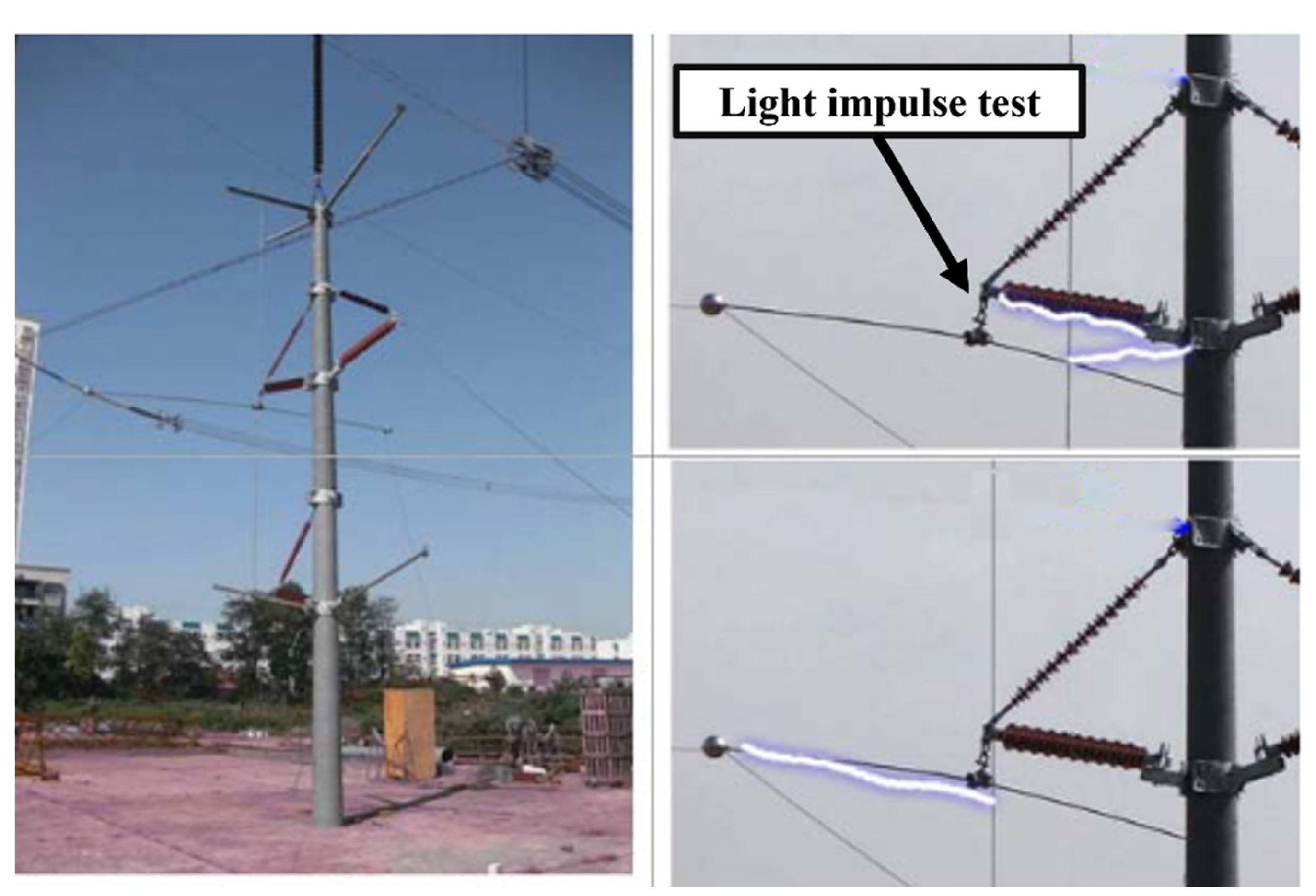
- 5.
- This high-strength aluminium alloy tower has good corrosion resistance and can avoid galvanic pollution through routine anti-corrosion maintenance.
- 6.
- The density of high-strength materials is 1/3 that of steel, reducing the construction difficulty and cost.
- 7.
- Under the same design conditions, the weight of a high-strength aluminium alloy tower is 10% lower than that of an iron tower.
- 8.
- High-strength aluminium alloy towers are suitable for transmission lines in coastal areas, industrial pollution areas, and rugged mountainous areas.
5. Future Research Directions
6. Conclusions
Author Contributions
Funding
Data Availability Statement
Conflicts of Interest
References
- Littler, D.J.; Davies, E.J.; Johnson, H.E. EHV Transmission, 3rd ed.; Elsevier: Amsterdam, The Netherlands, 1991; Volume K. [Google Scholar]
- Baharom, M. Composite Cross-Arms for Overhead Transmission. Ph.D. Thesis, School of Electrical Engineering, The University of Manchestor, Manchestor, UK, 2009. [Google Scholar]
- Sulaiman, S.S.; Khali, R.; Aminudin, N.H. Legal Issues and Challenges in Regulating the Rights to Wayleave in Malaysia. Int. J. Eng. Technol. 2018, 7, 174–177. [Google Scholar] [CrossRef]
- Raj, A.A.; Lee, C.P.; Sidek, M.F. Protection against EMF at Transmission Line and Tower. In Proceedings of the PECon IEEE International Conference on Power and Energy, Virtual, 7–8 December 2020; pp. 376–381. [Google Scholar] [CrossRef]
- Das, H.; Gogoi, K.; Chatterjee, S. Analysis of the effect of electric field due to High Voltage Transmission lines on humans. In Proceedings of the 2015 1st Conference on Power, Dielectric and Energy Management at NERIST (ICPDEN), Itanagar, India, 10–11 January 2015; pp. 1–4. [Google Scholar] [CrossRef]
- Lesco Tells Nepra Shifting Transmission Lines Impossible—Pakistan—DAWN.COM. Available online: https://www.dawn.com/news/1678971 (accessed on 11 August 2022).
- High-Voltage Cables above Indirapuram Parks Pose Risk for Visitors. Available online: https://timesofindia.indiatimes.com/blogs/no-filter/high-tension-lines-above-indirapuram-parks-pose-risk-for-visitors/ (accessed on 15 August 2022).
- Ferguson, J.; Gibbon, R. Overhead transmission lines—Refurbishment and developments. Power Eng. 1994, 8, 109–118. [Google Scholar] [CrossRef]
- Daconti, J.; Lawry, D. Increasing power transfer capability of existing transmission lines. In Proceedings of the IEEE Power Engineering Society Transmission and Distribution Conference, New Orleans, LA, USA, 25–28 April 2003. [Google Scholar] [CrossRef]
- Ntuli, M.; Xezile, R.; Mbuli, N.; Pretorius, J.H.C.; Motsoeneng, L. Increasing the capacity of transmission lines via current uprating: An updated review of benefits, considerations and developments. In Proceedings of the 2016 Australasian Universities Power Engineering Conference, AUPEC, Brisbane, Australia, 25–28 September 2016. [Google Scholar] [CrossRef]
- Mateescu, E.; Marginean, D.; Florea, G.; Gal, S.I.A.; Matea, C. Reconductoring using HTLS conductors. Case study for a 220 kV double circuit transmission LINE in Romania. In Proceedings of the IEEE International Conference on Transmission and Distri-bution Construction and Live Line Maintenance, ESMO, Providence, RI, USA, 16–19 May 2011; pp. 1–7. [Google Scholar] [CrossRef]
- Bedialauneta, M.; Fernandez, E.; Albizu, I.; Mazon, A. Comparison of the theoretical and the actual behavior of an overhead conductor in operation. In Proceedings of the IEEE Power and Energy Society Conference and Exposition in Africa: Intelligent Grid Integration of Renewable Energy Resources (PowerAfrica), Johannesburg, South Africa, 9–13 July 2012. [Google Scholar] [CrossRef]
- Riba, J.-R.; Bogarra, S.; Gómez-Pau, Á.; Moreno-Eguilaz, M. Uprating of transmission lines by means of HTLS conductors for a sustainable growth: Challenges, opportunities, and research needs. Renew. Sustain. Energy Rev. 2020, 134, 110334. [Google Scholar] [CrossRef]
- Larruskain, D.; Zamora, I.; Abarrategui, O.; Iraolagoitia, A.; Gutiérrez, M.; Loroño, E.; De La Bodega, F. Power transmission capacity upgrade for overhead lines. Renew. Energy Power Qual. J. 2006, 1, 221–227. [Google Scholar] [CrossRef]
- Mazon, A.; Zamora, I.; Eguía, P.; Torres, E.; Miguelez, S.; Medina, R.; Saenz, J. Analysis of Traditional Suspension Strings with GTACSR Conductors. IEEE Trans. Power Deliv. 2004, 19, 1198–1203. [Google Scholar] [CrossRef]
- Rao, N.P.; Mohan, S.J.; Lakshmanan, N. A study on failure of cross arms in transmission line towers during prototype testing. Int. J. Struct. Stab. Dyn. 2005, 5, 435–455. [Google Scholar] [CrossRef]
- Rao, N.P.; Knight, G.S.; Mohan, S.; Lakshmanan, N. Studies on failure of transmission line towers in testing. Eng. Struct. 2012, 35, 55–70. [Google Scholar] [CrossRef]
- Papailiou, K. Composite insulators are gaining ground-25 years of Swiss experience. In Proceedings of the IEEE Power Engineering Society Transmission and Distribution Conference, New Orleans, LA, USA, 11–16 April 1999; Volume 2, pp. 827–833. [Google Scholar] [CrossRef]
- I Performance: Combined Load Limitations of Composite Line Posts. 2022. Available online: https://www.inmr.com/combined-load-limitations-of-composite-line-posts (accessed on 18 March 2022).
- Kimoto, I.; Kito, K.; Ueno, K. Insulator Crossarms for 345-KV EHV Transmission Line. IEEE Trans. Power Appar. Syst. 1971, PAS-90, 756–767. [Google Scholar] [CrossRef]
- Barbarito, M.; Clerici, A.; Paris, L.; Pelacchi, P. New type of compact line for urban and suburban areas. In Proceedings of the 1989 International Conference on Overhead Line Design and Construction: Theory and Practice, London, UK, 28–30 November 1988; Volume 297, pp. 40–45. [Google Scholar]
- Cecchett, E.; Noferi, P.L.; Barbarit, M.; Cleric, A.; Pelacch, P.; Sadelmi, S. Compact Lines for Urban Areas: A New Solution. Dev. Built Environ. 2016, 15, 1–23. [Google Scholar]
- Gençoğlu, M.T. The Comparison of Ceramic and Non-Ceramic Insulators. e-J. New World Sci. Acad. 2007, 2, 245. [Google Scholar]
- Burkhardt, B.; Baettig, G.; Terrasi, G.P.; Papailiou, K.O.; Schmuck, F. New Solutions With Composite Insulators And Composite Structures For Compact Lines. In Proceedings of the 17th International Conference on Electricity Distribution, Barcelona, Spain, 12–15 May 2003; pp. 12–15. [Google Scholar]
- Albizu, I.; Mazon, A.J.; Zamora, I. Methods for increasing the rating of overhead lines. In Proceedings of the IEEE Russia Power Tech, St. Petersburg, Russia, 27 January 2005; pp. 1–6. [Google Scholar] [CrossRef]
- Khalid, K.; Hamami, M.; Cheong, N.K.; Fuad, S. Microwave reflection sensor for determination of decay in wooden cross-arms. In Proceedings of the IEEE International Conference on Properties and Applications of Dielectric Materials, Xi’an, China, 6 August 2002; pp. 595–598. [Google Scholar] [CrossRef]
- Rawi, I.M.; Rahman, M.S.A.; Kadir, M.Z.A.A.; Izadi, M. Wood and fiberglass crossarm performance against lightning strikes on transmission towers. In Proceedings of the IPST—International Conference on Power Systems Transients, Seoul, Korea, 26–29 June 2017. [Google Scholar]
- Wong, K.L.; Pathak, S.; Yu, X.H. Leakage current flow through wooden pole structures of varying age on overhead distribution system. In Proceedings of the 2007 Australasian Universities Power Engineering Conference, Perth, WA, Australia, 9–12 December 2007; pp. 1–6. [Google Scholar] [CrossRef]
- Khalida, K.; Sahrjb, M.H.; Keonga, N.K.; Fuadc, S.A. Microwave dielectric properties of wooden cross-arms. In Proceedings of the SPIE’s International Symposium on Optical Science, Engineering, and Instrumentation, Denver, CO, USA, 18–23 July 1999; Volume 3752. [Google Scholar]
- Grzybowski, S. Electrical performance of 115 kV transmission lines fiberglass crossarms aged in field. In Proceedings of the 5th International Conference on Properties and Applications of Dielectric Materials, Seoul, Korea, 25–30 May 1997; Volume 2, pp. 774–777.
- Li, H.-M.; Deng, S.-C.; Wei, Q.-H.; Wu, Y.-N.; Xiang, Q.-Q. Research on composite material towers used in 110 kV overhead transmission lines. In Proceedings of the 2010 International Conference on High Voltage Engineering and Application, ICHVE, New Orleans, LA, USA, 11–14 October 2010; pp. 572–575. [Google Scholar] [CrossRef]
- Chandrashekhara, K.; Watkins, S.E.; Nanni, A.; Kumar, P. Design and technologies for a smart composite bridge. In Proceedings of the 2004 IEEE Intelligent Transportation Systems Conference, Washington, DC, USA, 3–6 October 2004. [Google Scholar] [CrossRef]
- Kopsidas, K.; Rowland, S.M.; Baharom, M.N.R.; Cotton, I. Power transfer capacity improvements of existing overhead line systems. In Proceedings of the 2010 IEEE International Symposium on Electrical Insulation, San Diego, CA, USA, 6–9 June 2010; pp. 1–5. [Google Scholar] [CrossRef]
- Selvaraj, M.; Kulkarni, S.; Babu, R.R. Analysis and experimental testing of a built-up composite cross arm in a transmission line tower for mechanical performance. Compos. Struct. 2013, 96, 1–7. [Google Scholar] [CrossRef]
- Peesapati, V.; Zachariades, C.; Li, Q.; Rowland, S.M.; Cotton, I.; Allison, F.; Chambers, D. 3D electric field computation of a composite cross-arm. In Proceedings of the Conference Record of IEEE International Symposium on Electrical Insulation, San Juan, PR, USA, 10–13 June 2012; pp. 464–468. [Google Scholar] [CrossRef]
- Zachariades, C.; Rowland, S.M.; Cotton, I. Real-time monitoring of leakage current on insulating cross-arms in relation to local weather conditions. In Proceedings of the 2013 IEEE Electrical Insulation Conference, EIC, Ottawa, ON, Canada, 2–5 June 2013; pp. 397–401. [Google Scholar] [CrossRef]
- Yang, X.; Li, N.; Peng, Z.; Liao, J.; Wang, Q. Potential distribution computation and structure optimization for composite cross-arms in 750 kV AC transmission line. IEEE Trans. Dielectr. Electr. Insul. 2014, 21, 1660–1669. [Google Scholar] [CrossRef]
- Yang, X.; Wang, Q.; Wang, H.; Zhang, S.; Peng, Z. Transient electric field computation for composite cross-arm in 750 kV AC transmission line under lightning impulse voltage. IEEE Trans. Dielectr. Electr. Insul. 2016, 23, 1942–1950. [Google Scholar] [CrossRef]
- Pei, H.; Zhang, Q.; Zhang, L.; Zhou, F.; Chen, C.; Niu, K. Application of Compact Type Composite Cross arm in Tower Design. In Proceedings of the 4th Annual International Conference on Material Engineering and Application (ICMEA 2017), Wuhan, China, 15–17 December 2018. [Google Scholar] [CrossRef]
- Saudeger, K.; Bozkurt, A. Economic analysis of 400 KV transmission towers with cross arms in-sulators. Int. J. Acad. Res. Reflect. 2017, 5, 55–62. [Google Scholar]
- Beddu, S.; Syamsir, A.; Ishak, Z.A.M.; Yusof, Z.M.; Hudi, N.S.; Nabihah, S. Creep behavior of glass fibre reinforced polymer structures in crossarms transmission line towers. In Proceedings of the AIP Conference Proceedings, Maharashtra, India, 5–6 July 2018; Volume 2031. [Google Scholar] [CrossRef]
- Sanjay, M.R.; Yogesha, B. Studies on Natural/Glass Fiber Reinforced Polymer Hybrid Composites: An Evolution. Mater. Today Proc. 2017, 4, 2739–2747. [Google Scholar] [CrossRef]
- Asyraf, M.R.M.; Ishak, M.R.; Sapuan, S.M.; Yidris, N.; Ilyas, R.A.; Rafidah, M.; Razman, M.R. Potential Application of Green Composites for Cross Arm Component in Transmission Tower: A Brief Review. Int. J. Polym. Sci. 2020, 2020, 8878300. [Google Scholar] [CrossRef]
- Wang, Z.; Liu, J.; Lu, Z.; Hui, D. Mechanical behavior of composited structure filled with tandem honeycombs. Compos. Part B Eng. 2017, 114, 128–138. [Google Scholar] [CrossRef]
- Li, H.; Xiang, N.; Bao, H.; Jin, M.; Ding, L. Lightning protection performance of quadruple-circuit 500 kV transmission lines on the same tower with composite cross arm. Energy Rep. 2021, 8, 520–526. [Google Scholar] [CrossRef]
- Aktay, L.; Çakırolu, C.; Güden, M. Quasi-Static Axial Crushing Behavior of Honeycomb-Filled Thin-Walled Aluminum Tubes. Open Mat. Sci. J. 2011, 5, 184–193. [Google Scholar] [CrossRef]
- Yin, K.; da Silva, F.F.; Bak, C.L.; Zhang, H.; Wang, Q.; Skouboe, H. Electric Field Computation and Optimization for A 400 kV Y-shaped Composite Cross-arm. In Proceedings of the ICEMPE 2021—3rd International Conference on Electrical Materials and Power Equipment, Chongqing, China, 11–15 April 2021; pp. 1–4. [Google Scholar] [CrossRef]
- Asyraf, M.R.M.; Ishak, M.R.; Syamsir, A.; Amir, A.L.; Nurazzi, N.M.; Norrrahim, M.N.F.; Asrofi, M.; Rafidah, M.; Ilyas, R.A.; Rashid, M.Z.A.; et al. Filament-wound glass-fibre reinforced polymer composites: Potential applications for cross arm structure in transmission towers. Polym. Bull. 2022, 0123456789. [Google Scholar] [CrossRef]
- Klumb, F.R.; Chairman, G. 1986 IEEE/PES T&D Conference Update. In Proceedings of the Transmission and Distribution Conference and Exposition, Anaheim, CA, USA, 14–19 September 1986; Available online: https://ieeexplore.ieee.org/stamp/stamp.jsp?arnumber=5526542 (accessed on 10 October 2022).
- Dai, J.; Jia, Y.; Zhao, H.; Song, S.; Li, Z.; Wu, X. Investigation on the insulating properties of FRP composites cross arms for 10 kv distribution network. IET Conf. Publ. 2020, 2020, 1450–1453. [Google Scholar] [CrossRef]
- An, L.; Yang, B. Structure Design and Analysis for 110 kV FRP Transmission Pole. In Proceedings of the International Con-ference on Logistics, Engineering, Management and Computer Science, Shenyang, China, 29–31 July 2015. [Google Scholar] [CrossRef]
- Lu, J.; Zhao, C.; Jiang, Z.; Xie, P.; Hu, J. Simulation and experiment of a composite insulator with lightning protection and icing flashover prevention. In Proceedings of the 2014 International Conference on Lightning Protection, ICLP, Shanghai, China, 13–17 October 2014; pp. 1987–1991. [Google Scholar] [CrossRef]
- Cotton, I.; Rowland, S.M.; Chambers, D.; Baharom, N.R.B.; Weatherby, N.; Thorne, M. Support Towers, Insulating Cross-Arms and Insulating Members for High Voltage Power Networks. Patent CA2771695C, 24 February 2011. [Google Scholar]
- Izumi, K.; Takahashi, T.; Homma, H.; Kuroyagi, T. Development of line post type polymer insulation arm for 154 kV. IEEE Trans. Power Deliv. 2000, 15, 1304–1310. [Google Scholar] [CrossRef]
- Wood, B.; Moore, T. Modifying Existing 138-kV Transmission Towers to 230-kV Capacity. In Proceedings of the 2005/2006 IEEE/PES Transmission and Distribution Conference and Exhibition, Dallas, TX, USA, 21–24 May 2006; pp. 1139–1143. [Google Scholar] [CrossRef]
- Alipour, H.J.; Aminnejad, S.; Jazaeri, M. Decreasing the Right of Way of Transmission Lines by Using Towers with Polymer Insulation Arms. In Proceedings of the POWERENG 2007—International Conference on Power Engineering—Energy and Electrical Drives Proceedings, Setubal, Portugal, 12–14 April 2007; pp. 571–576. [Google Scholar] [CrossRef]
- Zachariades, C.; Cotton, I.; Rowland, S.M.; Peesapati, V.; Green, P.; Chambers, D.; Queen, M. A coastal trial facility for high voltage composite cross-arms. In Proceedings of the Conference Record of IEEE International Symposium on Electrical Insulation, San Juan, PR, USA, 10–13 June 2012; pp. 78–82. [Google Scholar] [CrossRef]
- Zachariades, C.; Rowland, S.M.; Cotton, I.; Green, P.R.; Veerappan, C.A. A trial installation of high voltage composite cross-arms. In Proceedings of the 17th International Symposium on High Voltage Engineering, Hannover, Germany, 22–26 August 2011. [Google Scholar]
- Dumora, D.; Feldmann, D.; Gaudry, M. Mechanical behavior of flexurally stressed composite insulators. IEEE Trans. Power Deliv. 1990, 1999, 1660–1669. [Google Scholar] [CrossRef]
- Shen, Z.; Yuze, L.; Bo, Z. Electric Fields Distribution of EHV AC Transmission Line Composite Insulators with Internal Conductive Defects. In Proceedings of the 2019 Asia Power and Energy Engineering Conference, APEEC, Macao, China, 1–4 December 2019; pp. 115–120. [Google Scholar] [CrossRef]
- Lines, O.D. IEEE Standards. IEEE Spectr. 2012, 12, 98. [Google Scholar] [CrossRef]
- Gao, Y.; Wang, E.; Li, Y.; Li, H. Analysis of transient electric field for epoxy spacer under lightning impulse voltage. IEEE Trans. Magn. 2006, 42, 595–598. [Google Scholar] [CrossRef]
- Yao-Qin, L.; Feng, H.; Jing, N. Test and Simulation Analysis on the Electric Field Distribution Characteristics of UHVAC Composite Cross-arm Fittings. In Proceedings of the iSPEC 2019—2019 IEEE Sustainable Power and Energy Conference: Grid Modernization for Energy Revolution, Beijing, China, 21–23 November 2019; pp. 2905–2910. [Google Scholar] [CrossRef]
- Hu, C.; Liu, T.; Liu, K.; Wu, T.; Xiao, B.; Peng, Y.; Su, Z.; Tang, P.; Le, X. Investigation on 110kV composite material pole: Effects of grounding methods on insulation of conductor-pole gaps. In Proceedings of the ICHVE 2016 IEEE International Conference on High Voltage Engineering and Application, Chengdu, China, 19–22 September 2016. [Google Scholar] [CrossRef]
- Rowland, S.M.; Maclaren, R.; Cotton, I.; Chambers, D.; Peesapati, V.; Zachariades, C. Development of insulating cross-arms for compact HV lattice tower structures. In Proceedings of the CIGRE Session 45–45th International Conference on Large High Voltage Electric Systems, Paris, France, 24–29 August 2014. [Google Scholar]
- Luís, J.; Martins, B. Quality and Durability Control of GFRP Structures Extended Abstract; Universidade Technica de Lisboa: Lisboa, Portugal, 2011. [Google Scholar]
- Guo, C.; Liu, L.; Yu, H.; Ma, Y.; Mei, H.; Wang, L. Electric Field Distribution Calculation and Analysis of Composite Insulators Operating on Double Circuit Transposition Tower in 500 kV Transmission Lines. In Proceedings of the 2nd International Conference on Electrical Materials and Power Equipment (ICEMPE), Guangzhou, China, 7–10 April 2019; pp. 486–489. [Google Scholar] [CrossRef]
- Amir, A.; Ishak, M.; Yidris, N.; Zuhri, M.; Asyraf, M. Potential of Honeycomb-Filled Composite Structure in Composite Cross-Arm Component: A Review on Recent Progress and Its Mechanical Properties. Polymers 2021, 13, 1341. [Google Scholar] [CrossRef]
- Wang, Z. Recent advances in novel metallic honeycomb structure. Compos. Part B Eng. 2019, 166, 731–741. [Google Scholar] [CrossRef]
- Jahangiri, T.; Wang, Q.; Bak, C.L.; da Silva, F.F.; Skouboe, H. Electric stress computations for designing a novel unibody composite cross-arm using finite element method. IEEE Trans. Dielectr. Electr. Insul. 2017, 24, 3567–3577. [Google Scholar] [CrossRef]
- Anbarasan, R.; Usa, S. Electrical field computation of polymeric insulator using reduced dimension modeling. IEEE Trans. Dielectr. Electr. Insul. 2015, 22, 739–746. [Google Scholar] [CrossRef]
- Jahangiri, T.; Wang, Q.; da Silva, F.F.; Bak, C.L. Overview of Composite-Based Transmission Pylons. In Lecture Notes in Electrical Engineering; Springer: Berlin, Germany, 2020; pp. 1–13. [Google Scholar] [CrossRef]
- Wang, Q.; Bak, C.L.; da Silva, F.F.; Bystrup, E. A state of the art review-methods to evaluate electrical performance of composite cross-arms and composite-based pylons. In Proceedings of the 34th Electrical Insulation Conference, EIC, Montréal, QC, Canada, 19–22 June 2016; pp. 501–506. [Google Scholar] [CrossRef]
- Khennane, A. Filament winding processes in the manufacture of advanced fibre-reinforced polymer (FRP) composites. In Advanced Fibre-Reinforced Polymer (FRP) Composites for Structural Applications; Elsevier: Amsterdam, The Netherlands, 2013; pp. 187–206. [Google Scholar] [CrossRef]
- Ul-Haq, A.; Hassan, M.S.; Jalal, M.; Ahmad, S.; Anjum, M.A.; Khalil, I.U.; Waqar, A. Cross-Border Power Trade and Grid Interconnection in SAARC Region: Technical Standardization and Power Pool Model. IEEE Access 2019, 7, 178977–179001. [Google Scholar] [CrossRef]
- Stracqualursi, E.; Araneo, R. Transient impedance of grounding grids with different soil models. In Proceedings of the 21st IEEE International Conference on Environment and Electrical Engineering, Bari, Italy, 7–10 September 2021; pp. 1–6. [Google Scholar] [CrossRef]
- Chowdhuri, P.; Li, S.; Yan, P. Rigorous analysis of back-flashover outages caused by direct lightning strokes to overhead power lines. IEE Proc. Gener. Transm. Distrib. 2002, 149, 58–65. [Google Scholar] [CrossRef]
- Silveira, F.H.; Almeida, F.S.; Visacro, S.; Zago, G.M. Influence of the current front time representation on the assessment of backflashover occurrence of transmission lines by deterministic and probabilistic calculation approaches. Electr. Power Syst. Res. 2021, 197, 107299. [Google Scholar] [CrossRef]
- Li, Z.-J.; Dai, M.; Gu, D.-X.; Deng, S.-C.; Li, H.-M.; Wei, Q.-H. Study on grounding design for lightning of tubular composite material towers in 110kV overhead transmission line. In Proceedings of the International Conference on High Voltage Engineering and Application, ICHVE, New Orleans, LA, USA, 11–14 October 2010; pp. 473–476. [Google Scholar] [CrossRef]
- Liu, W.; Liu, K.; Pan, M.; Xu, G. Research on electromagnetic character of 500/220 kV mixed-voltage quadruple-circuit transmission line. In Proceedings of the 12th International Conference on Environment and Electrical Engineering, EEEIC, Wroclaw, Poland, 5–8 May 2013; pp. 227–231. [Google Scholar] [CrossRef]
- Zhang, Z.F.; Yang, J.B.; Yang, F.L.; Li, Q.H. Design and Full-Scale Test for Cup-Type Steel Tubular Tower of UHV Transmission Line in Heavy Icing Area. Adv. Mater. Res. 2013, 732–733, 1074–1080. [Google Scholar] [CrossRef]
- Salunkhe, U.; Ghugal, Y.M. Analysis and Design of Three Legged 400 kv Double Circuit Steel Transmission Line Towers. Int. J. Civ. Eng. Technol. 2013, 4, 197–203. [Google Scholar]
- Selvaraj, M.; Kulkarni, S.; Rameshbabu, R. Performance Analysis of a Overhead Power Transmission Line Tower Using Polymer Composite Material. Procedia Mater. Sci. 2014, 5, 1340–1348. [Google Scholar] [CrossRef]
- Yuan, H.; Yao, J.; Zhuang, Y.; Yong, J. Research of differentiate technology and strategy of lightning protection for 500 kV transmission line JG-type tower. In Proceedings of the International Conference on Lightning Protection, ICLP, Shanghai, China, 11–18 October 2014; pp. 301–306. [Google Scholar] [CrossRef]
- Liu, Y.; Chen, S.; Huang, S. Evaluation of Corona Loss in 750 kV Four-Circuit Transmission Lines on the Same Tower Considering Complex Meteorological Conditions. IEEE Access 2018, 6, 67427–67433. [Google Scholar] [CrossRef]
- Hu, X.; Lin, Y.; Cui, Z.; Xing, H.; Zhu, B. Application Prospect of High Strength Aluminum Alloy in Transmission Tower. J. Phys. Conf. Ser. 2020, 1649, 012043. [Google Scholar] [CrossRef]
- Gao, S.; Liu, J.; Zhang, Y.; Luo, M. Analysis of Composite Tower Conductor Unbalanced Tension and Design of Regulating Device. In Proceedings of the 2021 IEEE 2nd China International Youth Conference on Electrical Engineering (CIYCEE), Chengdu, China, 15–17 December 2021; pp. 1–6. [Google Scholar] [CrossRef]
- Ahmed, R.; Abd Rahman, R.; Jamal, A.; Salem, A.A.; Saman, B.; Lau, K.Y.; Ghoneim, S.S.M. Field-Dependent Pollution Model under Polluted Environments for Outdoor Polymeric Insulators. Polymers 2022, 14, 516. [Google Scholar]
- Taniguchi, S.; Tsuboi, T.; Okabe, S. Observation results of lightning shielding for large-scale transmission lines. IEEE Trans. Dielectr. Electr. Insul. 2009, 16, 552–559. [Google Scholar] [CrossRef]
- Electric Power Industry Standard of the People’s Republic of China. In Technical Code for Designing 110–500 kV Overhead Transmission Line; China Electric Power Press: Beijing, China, 2009.
- Ghugal, Y.M.; State, M.; Salunkhe, U. Analysis and Design of Three and Four Legged 400 KV Steel Transmission Line Towers: Comparative Study Analysis and Design of Three and Four Legged 400 KV Steel Transmission Line Towers: Comparative Study. Int. J. Earth Sci. Eng. 2011, 4, 691–694. [Google Scholar]
- Yu, R.S.; Yang, Z.W.; Jin, T. Application Research on Lightning Rod for Shielding Failure Prevention Based on JG and ZGUT Type Tower. Appl. Mech. Mater. 2013, 291–294, 2139–2142. [Google Scholar] [CrossRef]
- Khalil, I.U.; Ul-Haq, A.; Mahmoud, Y.; Jalal, M.; Aamir, M.; Ahsan, M.U.; Mehmood, K. Comparative Analysis of Photovoltaic Faults and Performance Evaluation of its Detection Techniques. IEEE Access 2020, 8, 26676–26700. [Google Scholar] [CrossRef]
- Khalil, I.U.; Ahsan, M.; Ullah, I.; Adnan, A.; Khan, N.; Nawaz, S. International Symposium on Recent Advances in Electrical Engineering (RAEE). In Proceedings of the 2018 International Symposium on Recent Advances in Electrical Engineering (RAEE), Islamabad, Pakistan, 17–18 October 2018. [Google Scholar]
- Yin, H.; Wen, G.; Hou, S.; Chen, K. Crushing analysis and multiobjective crashworthiness optimization of honeycomb-filled single and tubular polygonal tubes. Mater. Des. 2011, 32, 4449–4460. [Google Scholar] [CrossRef]
- Gul, S.; Haq, A.U.; Jalal, M.; Anjum, A.; Khalil, I.U. A Unified Approach for Analysis of Faults in Different Configurations of PV Arrays and Its Impact on Power Grid. Energies 2019, 13, 156. [Google Scholar] [CrossRef]
- Ahmad, R.; Abd Rahman, R.; Salem, A.A.; Jamail, N.A.M.; Ab Rahman, A.; Hamid, H.A. Finite Element Analysis of Electric Field Distribution in C4F7N as an Alternative to SF6 For Electrical Insulation. In Proceedings of the 2021 3rd International Conference on High Voltage Engineering and Power Systems (ICHVEPS), Bandung, Indonesia, 5–6 October 2021; pp. 126–131. [Google Scholar]
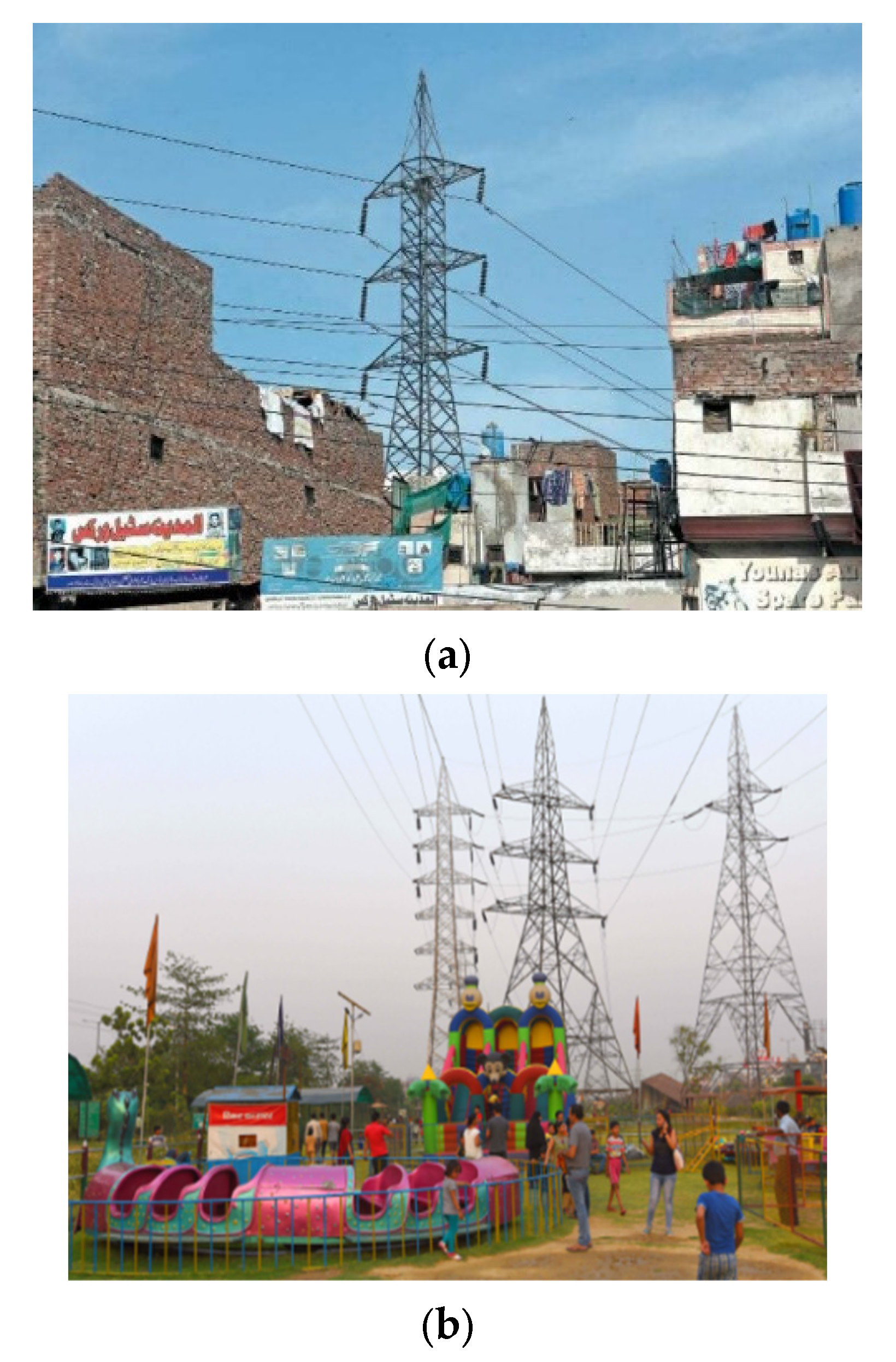
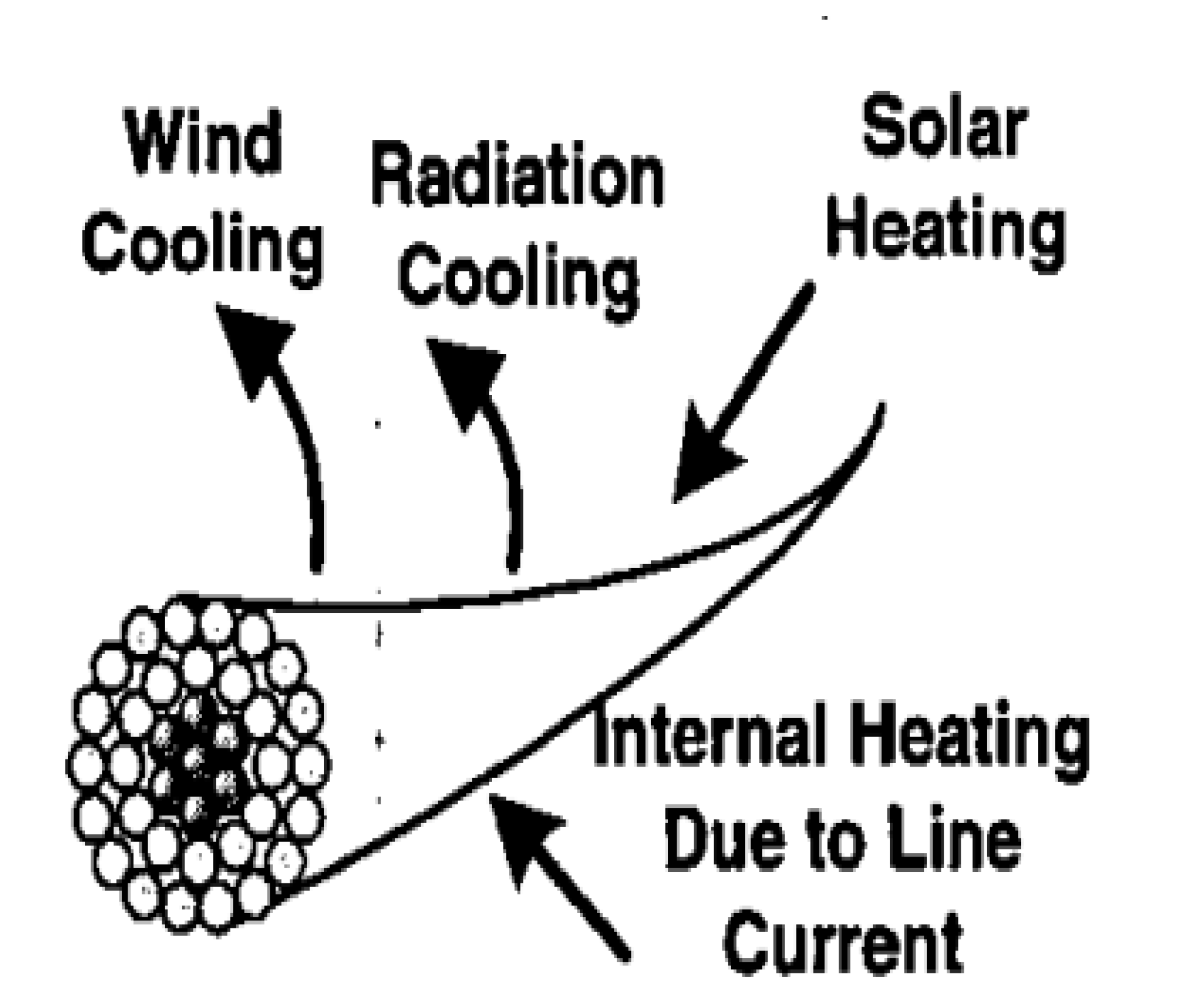

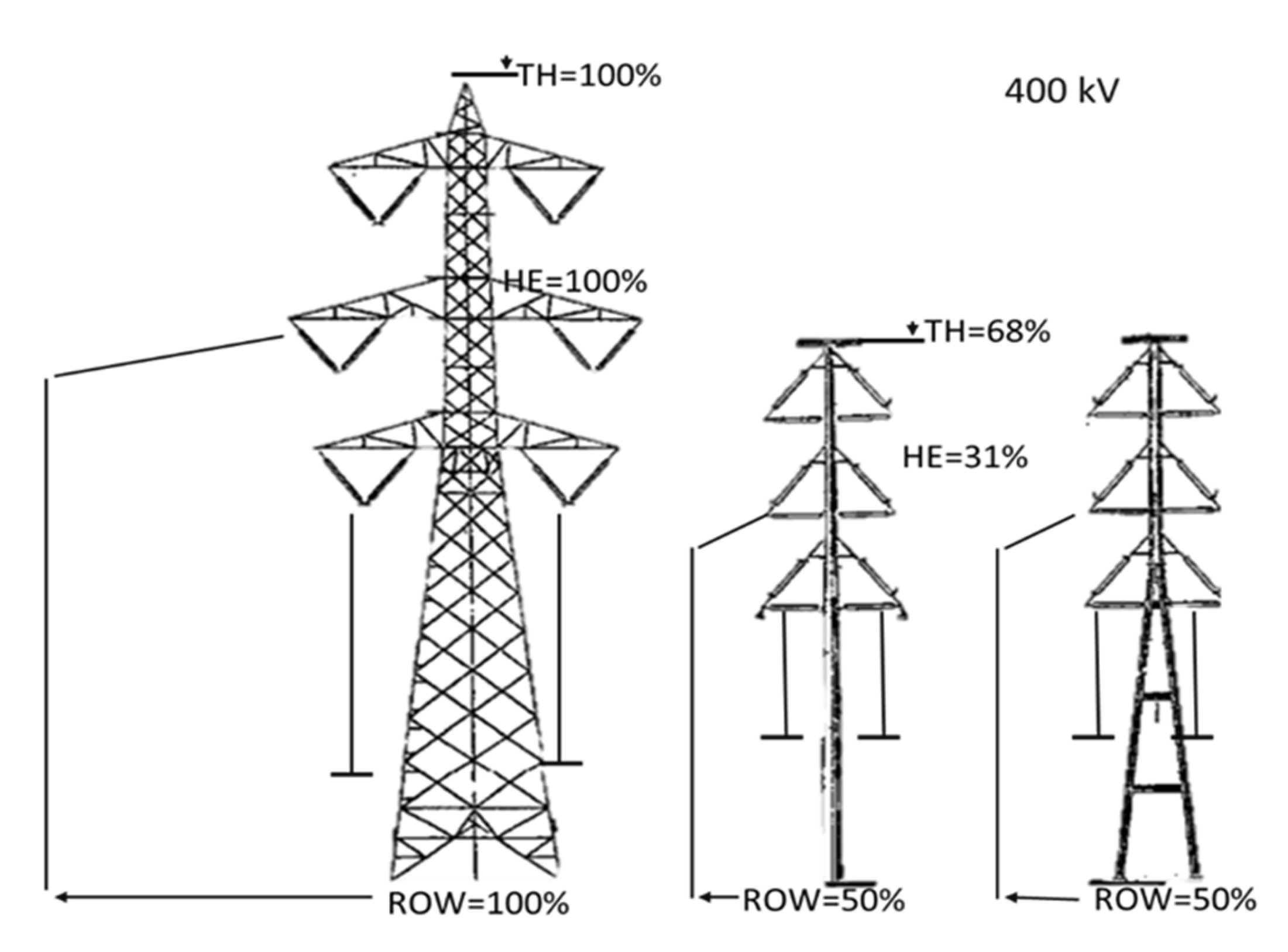
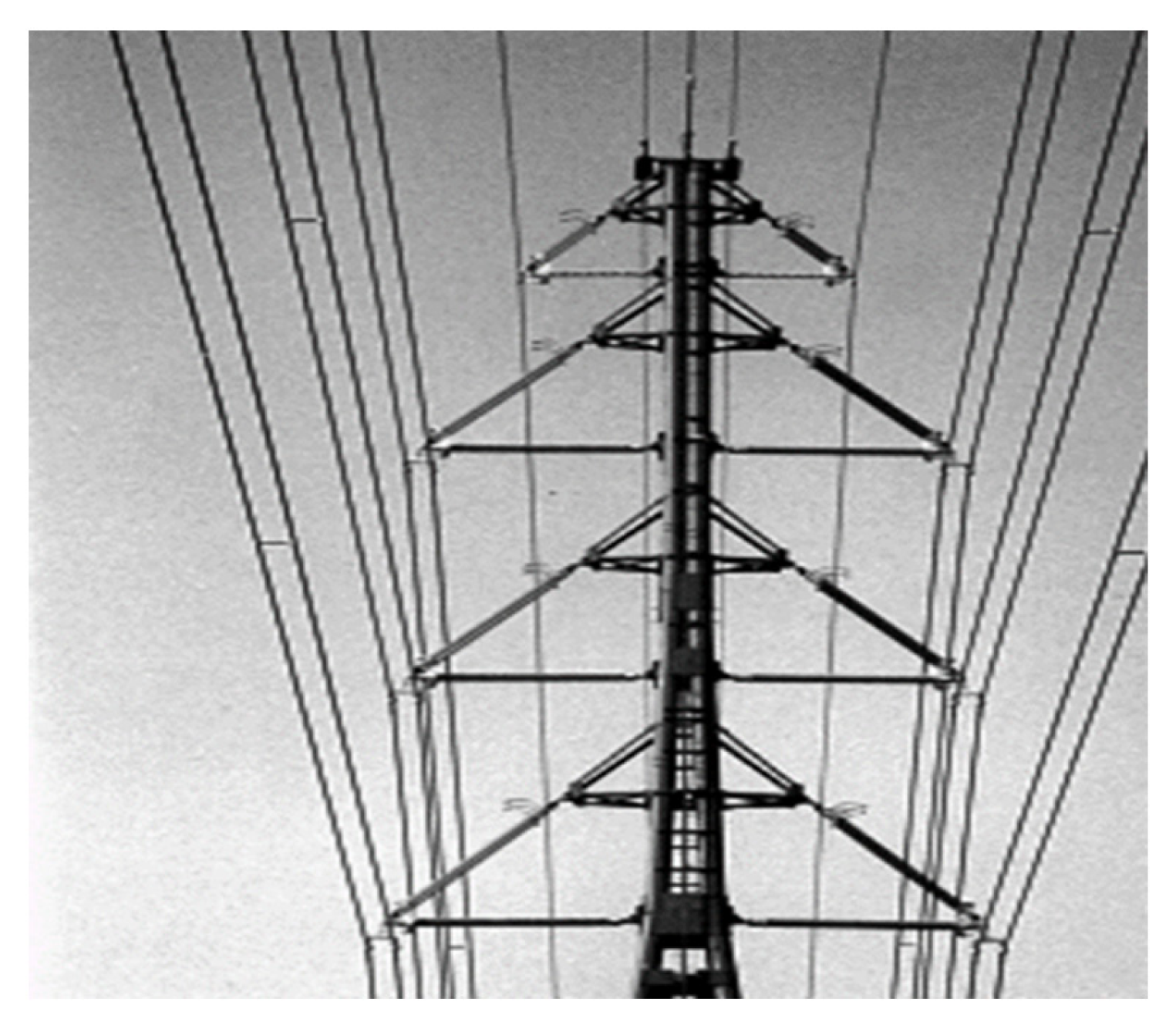



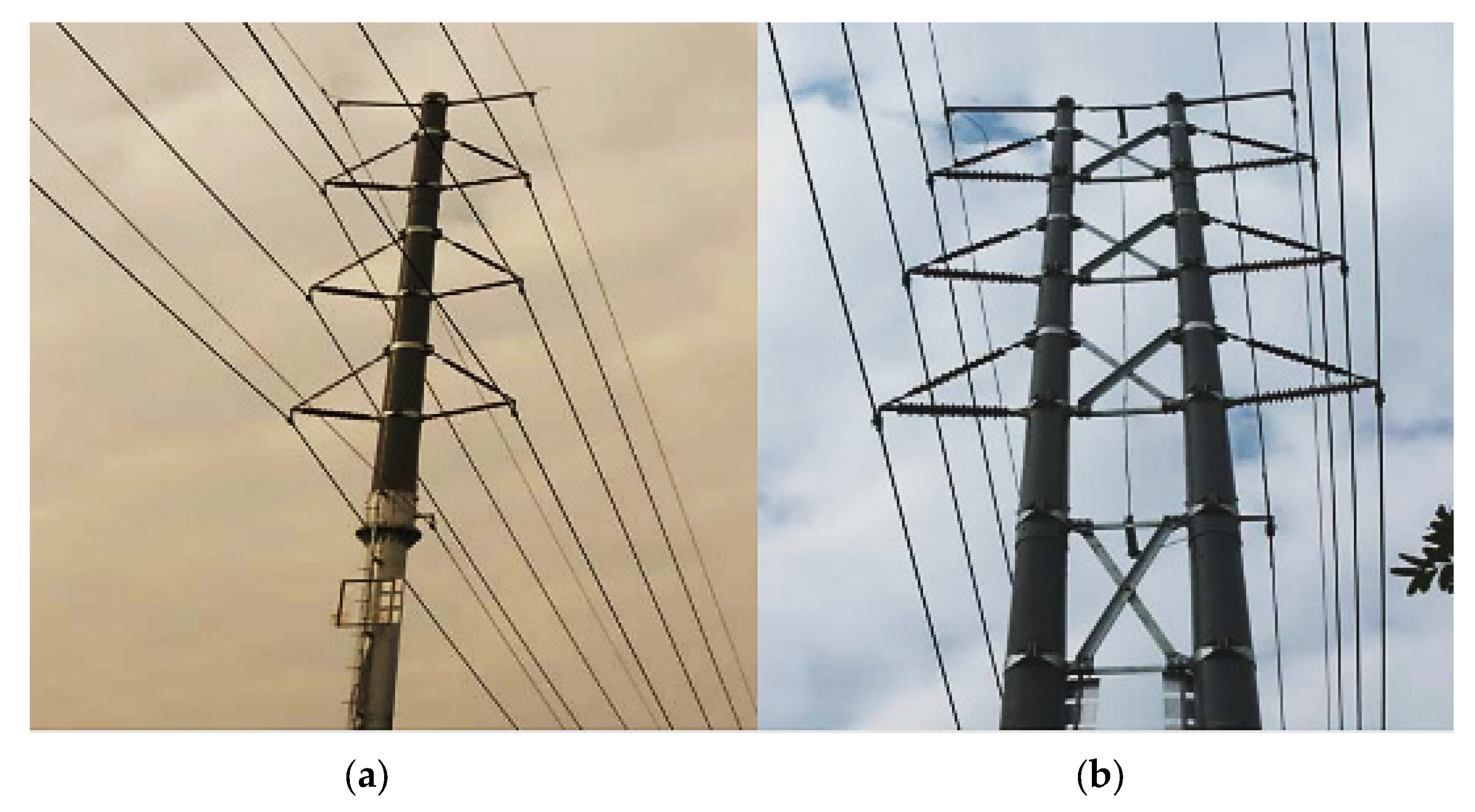
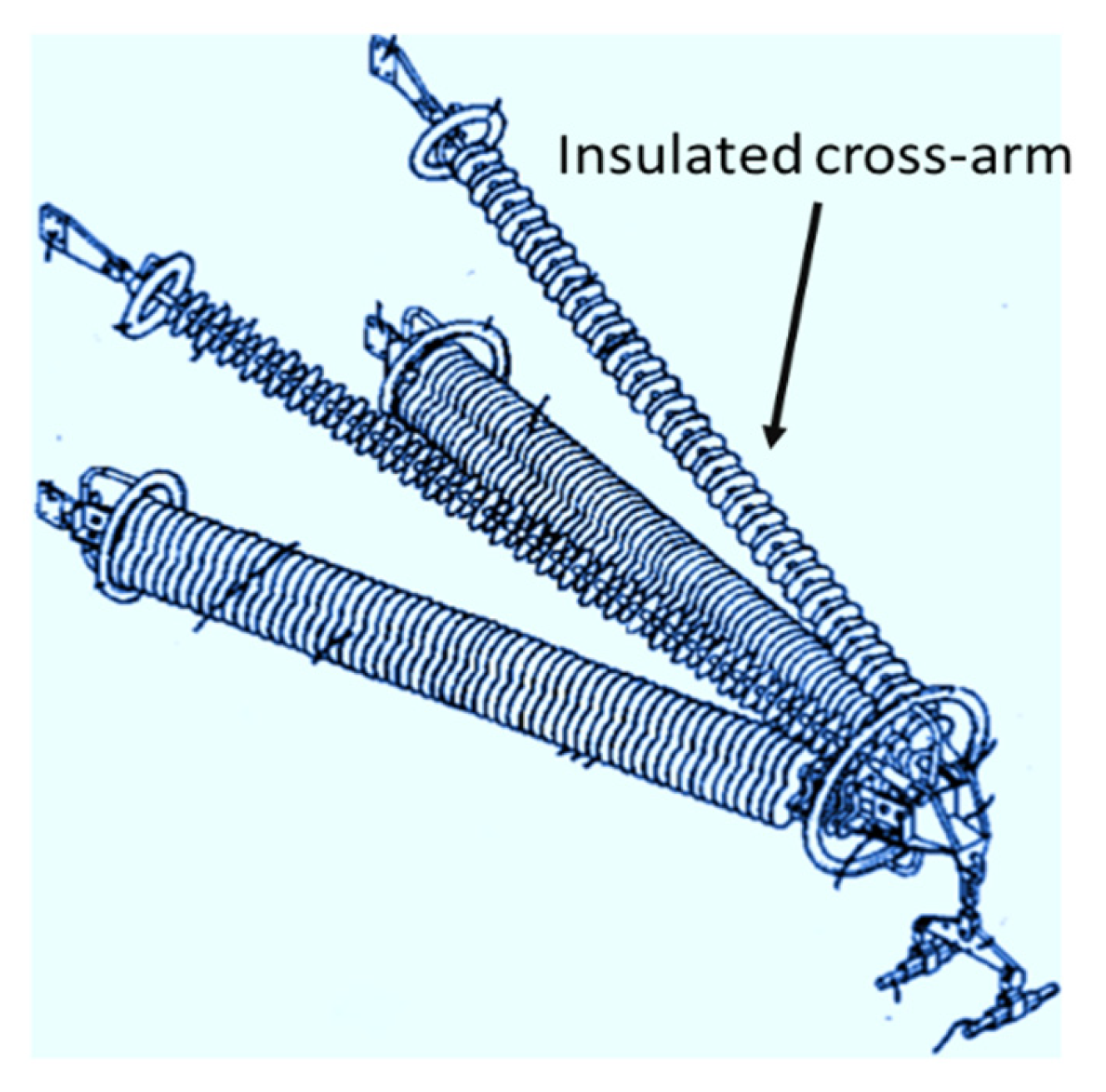

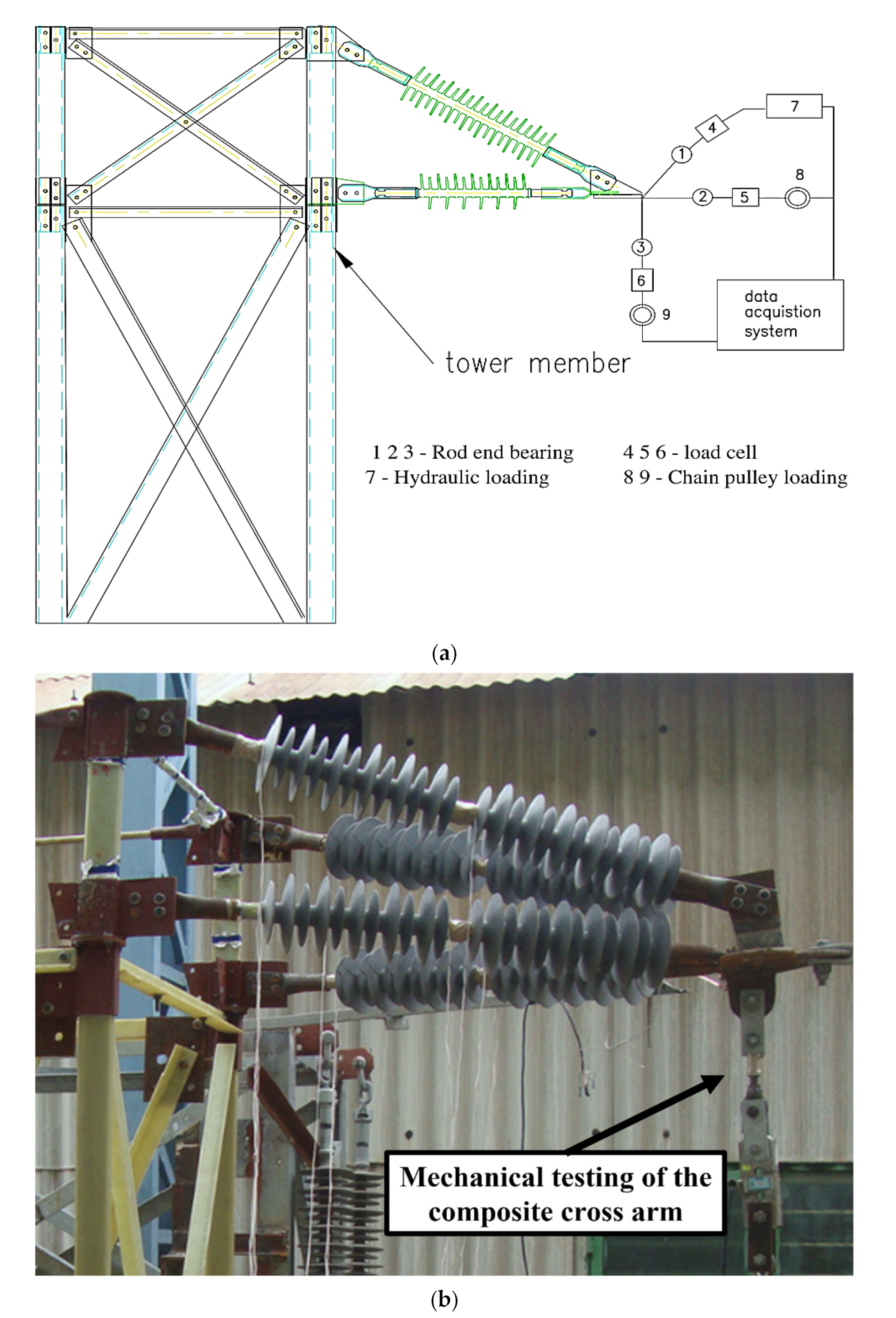





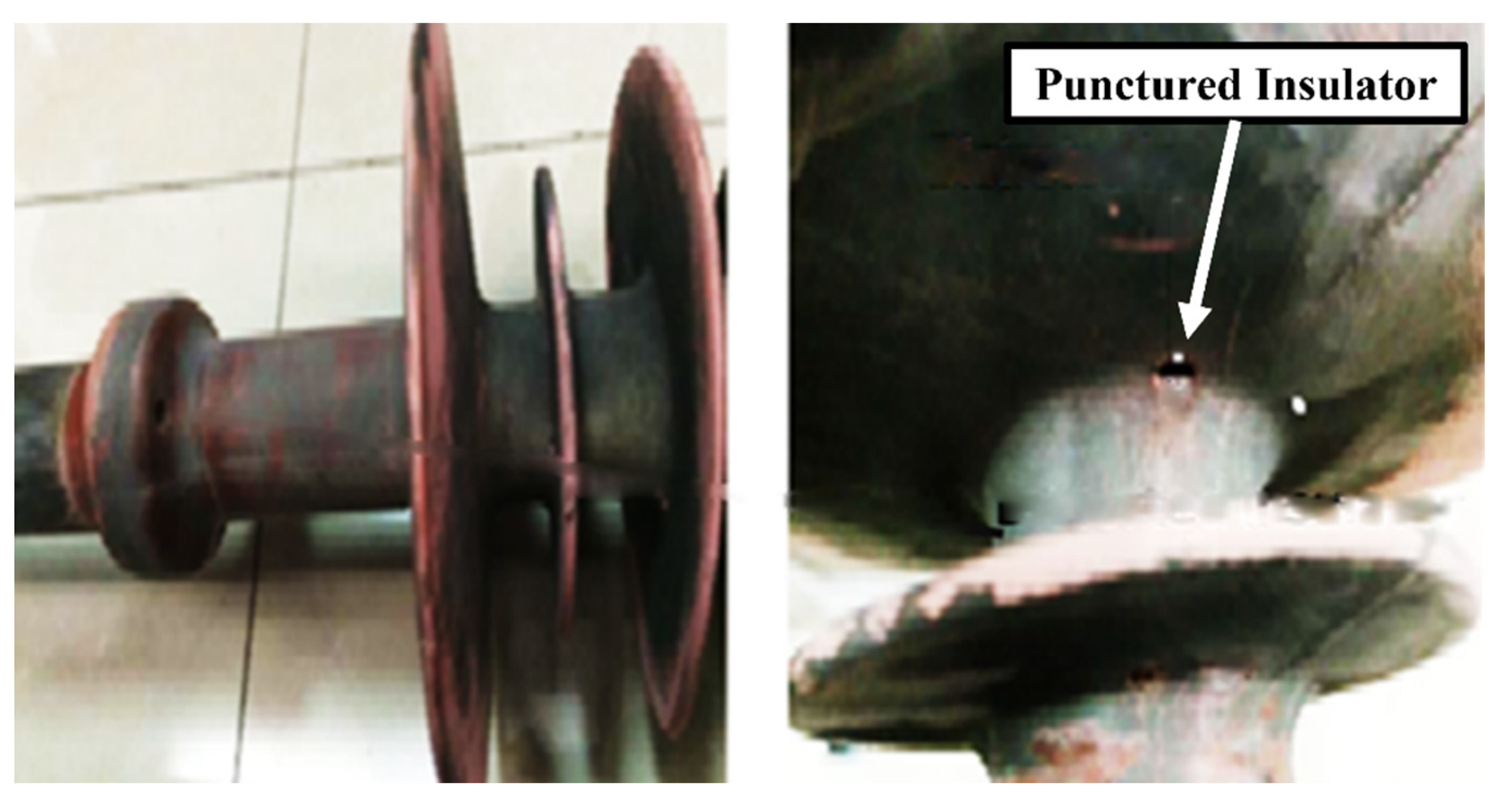

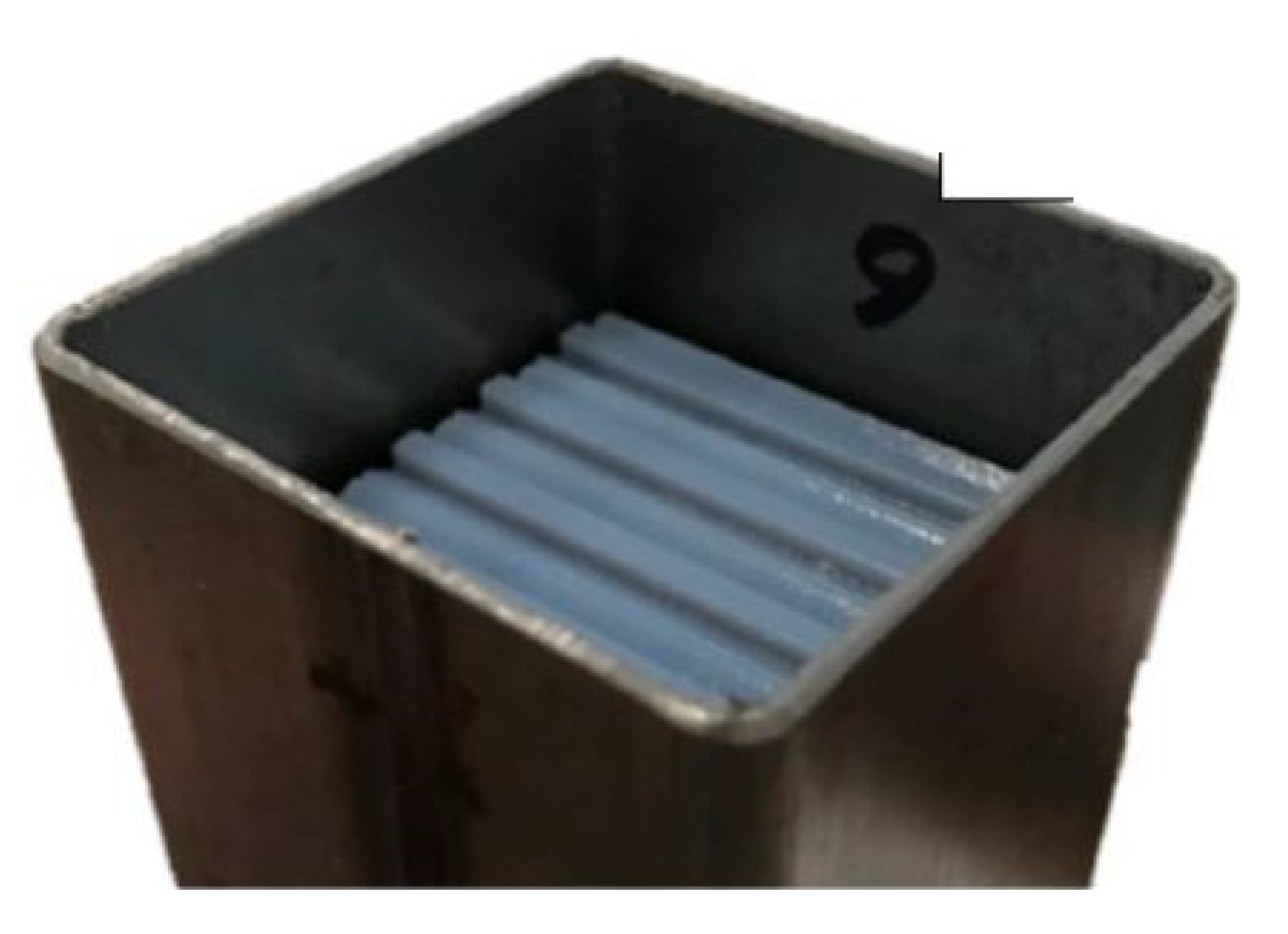
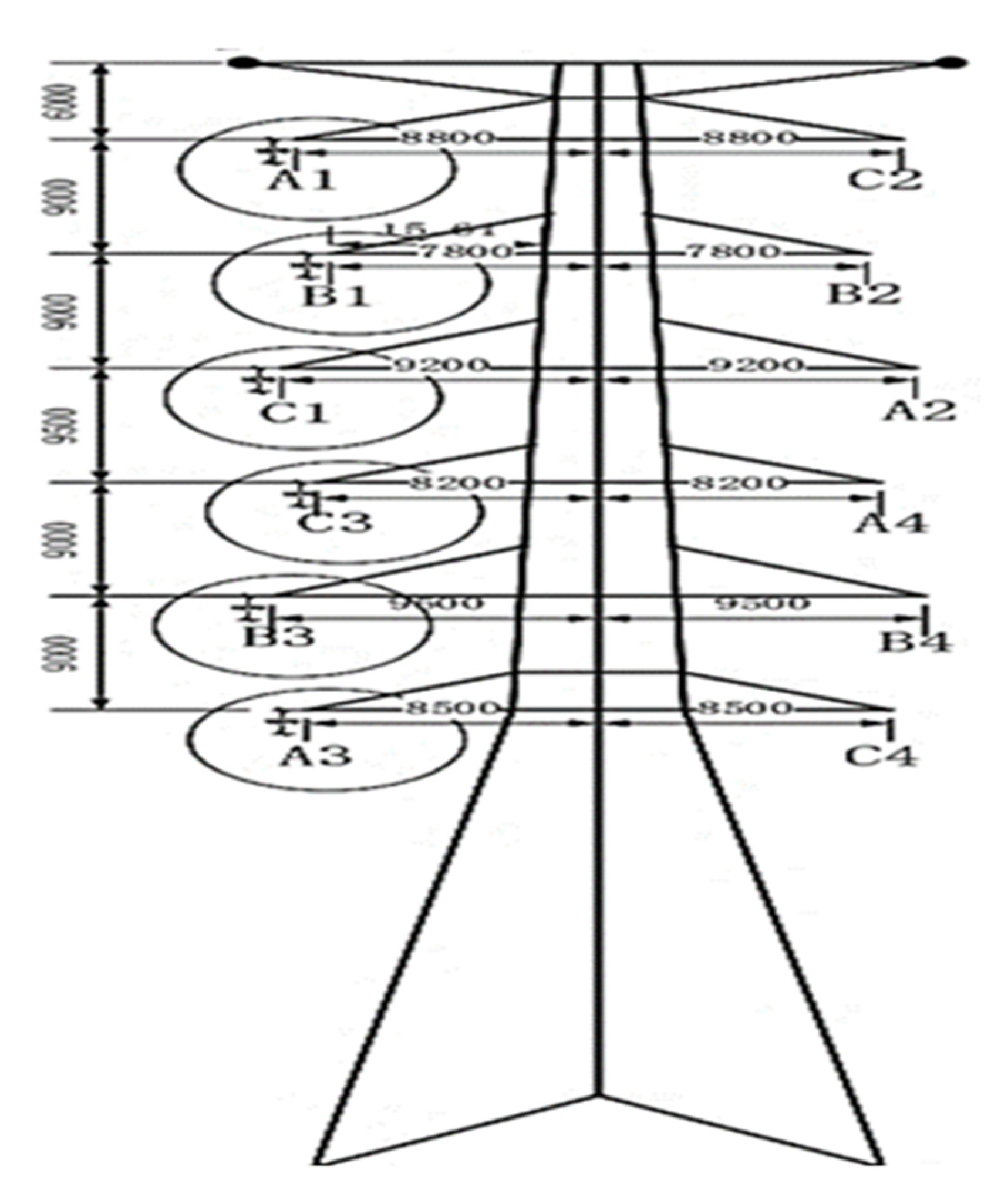



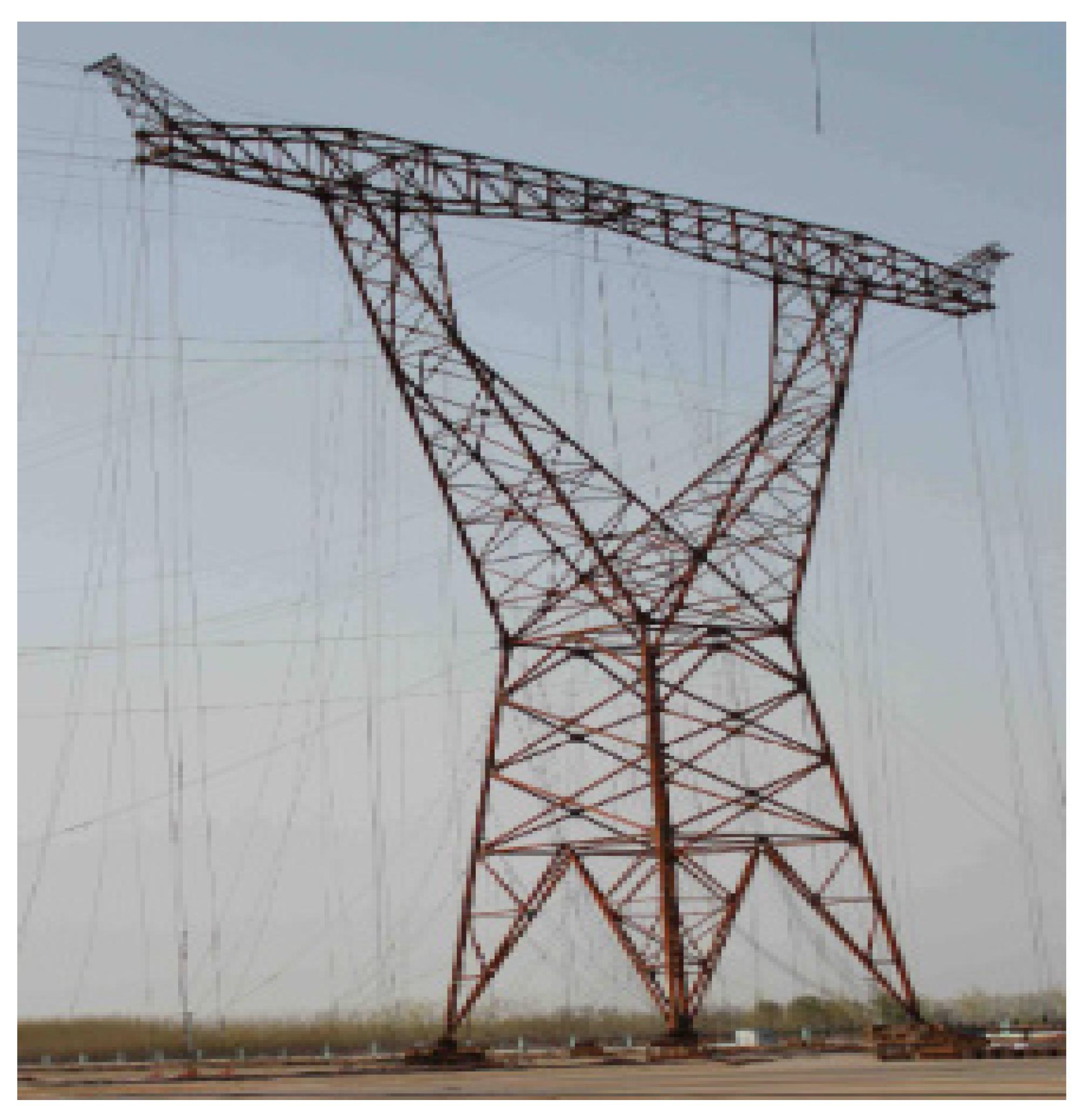

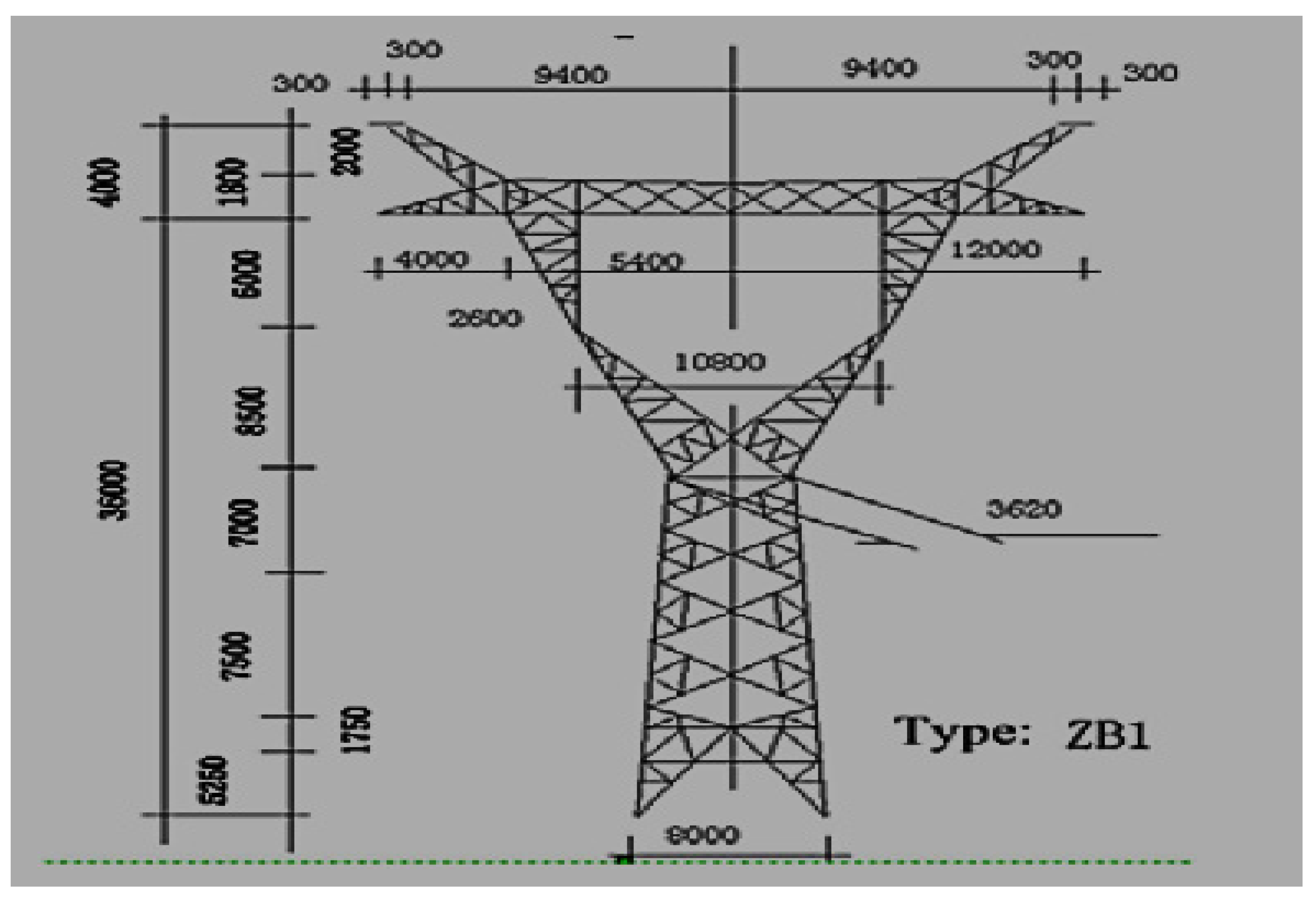

| Type | Structural Description | Shape |
|---|---|---|
| ACSS | Aluminium conductor steel, supported. |  |
| ACSS-TW | Trapezoid shape strands aluminium conductor, steel, supported. |  |
| G(Z)TACSR | Gap type ultra-thermal resistant aluminium alloy conductor, steel reinforced |  |
| T(K)ZACSR | Thermal (high strength) (ultra) aluminium alloy conductor, steel reinforced |  |
| X(Z)ACIR | Extra thermal-resistant aluminium alloy conductor, Invar reinforced |  |
| ACCR | Aluminium conductor composite reinforced. |  |
| ACCC | Aluminium conductor composite core |  |
| Ref No | Year | Material | Voltage Ratings | Contribution | Limitations | Country |
|---|---|---|---|---|---|---|
| [20] | 1960 | Ceramics | 345 kV | Insulated Cross-Arm, Reduced the Right of Way, and Decreased Cost. | High Weight, Large Deflection, Weak Resistance to Electrical Erosion and Electric Arc, Weak Hydrophobicity. | America |
| [21] | 1998 | Solid-Core Porcelain Insulator | 400 kV | Reduce the Right of Way while Reducing Tower Costs by up to 10% | Increase the Price of Insulator Fittings by 5%. Large Deflection, Weak Resistance of Electrical Erosion and Electric Arc, and Hydrophobicity. | Italy |
| [23] | 1998 | Silicone–rubber composite insulator as cross-arm | 400 kV | Compared with Porcelain Composite Insulators, Reduced Weights were Immune to Shock Load and had Withstanding Capability Against Intense Storms. | Large Deflection, Weak Resistance of Electrical Erosion and Electric Arc, and Weak Hydrophobicity. | Switzerland |
| [26] | 2000 | Wooden | 275 and 132 kV | Chengal Wooden Cross-Arms can Withstand the Weight of Power Cables and Insulators. | Natural Wood Defects and Attacks by Fungi, Termites, and Woodpeckers Increase their Decomposition and Ageing. | Malaysia |
| [30] | 2008 | Fibre Cross | 115 kV | CFO Voltages of Fibreglass Cross-Arms are 30–40% Higher than Wood in Dry Conditions and 40–50% Higher in Wet Conditions. | Durability and Lifespan Issues may Arise. | America |
| [31] | 2009 | Composite Cross-Arm | 110 and 210 kV | The Ability of Lightning Protection and Anti-Pollution Flashover for Transmission Lines has Been Improved; the Transmission Corridor Width has been Reduced. | Large Deflection, Weak Resistance of Electrical Erosion and Electric Arc, Weak Hydrophobicity. | China |
| [32] | 2010 | A New Invented Insulated Cross Cross-Arm | 275 and 400 kV | 1. Resistance against Buckling 2. Lightweight 3. Eliminate Conductor Swing 4. Forming a Rigid Spine by Pultrusion | United Kingdom | |
| [33] | 2012 | Insulated Cross-Arm | 275 kV | Improvement in Power Capacity | Operating at Temperatures Above 100 °C is Unrealistic due to the Annealing Mechanism that Damages the Conductor. | United Kingdom |
| [34] | 2012 | Composite Cross-Arm With FRP Pultruded Profile | 66 kV | Considerable Reduction in Transmission Corridor. | Durability and Lifespan Issues may Arise. | India |
| [35] | 2012 | Composite Cross-Arm | 400 kV | A Solution for the Upgrading of Existing Transmission Towers | How the Composite Cross-Arm will Work when It is Wet or Polluted when the Composite Insulators are Under the most Electrical Stress. | United Kingdom |
| [36] | 2013 | Two Insulated Cross-Arms | 230 kV | The Current Leakage Patterns Observed on the Novel Compression Insulators are like those Surveyed on Industry-Standard Tension Insulators. | The Base Leakage Current Profile of Compression of the Cross-Arm is High. | United Kingdom |
| [37] | 2014 | Composite Cross-Arm | 750 kV | Composite Cross-Arms have the Best Potential Distribution. | Without grading and Shielding Rings, End Fittings and Silicone Rubber Sheaths near the Line End are Exposed to Exceedingly High Electric Fields, have a Great Chance of Corona Discharge, and are Prone to Sheet Damage for Lengthy Periods. | China |
| [38] | 2015 | Composite Cross-Arm with Silicone Rubber Sheath. | 750 kV | The Maximum Electric Field Strength Difference is 0.6% to 2.9%. | During Ageing, the Insulating Properties Deteriorate. | China |
| [39] | 2017 | Composite Cross-Arm with Three Shape Towers | 400 kV | The Compact Type of Tower of The Composite Cross-Arm is the Best in Terms of Technology and Cost. | Durability and Ageing Issues may Arise. | China |
| [40] | 2017 | Composite Cross-Arm (Four Pultruded Structure Components) | 400 kV | Costs are Reduced, and the Span Between Towers Increased. | Durability and Lifespan Issues may Arise. | Turkey |
| [41] | 2018 | GFRP Pultruded | 275 kV | Lightweight, Mould Ability, High-Quality Surface Finishes | Cyclic Wind Loading could cause Tiny Cracks in the Cross-Arms. Extreme Heat and Moisture cause Hydrothermal Ageing of Composites. | Malaysia |
| [42] | 2019 | Cross-Arm is made from Composite Material with Suspension Porcelain Insulators. | 500 kV | The Composite Insulators are Vulnerable | The Distribution of Electric Fields is Non-Uniform along the Composite Insulator. | Guangzhou, China |
| [43] | 2020 | Green Composite Material | Excellent Mechanical Ability and the Material Itself, Green Technology. | There is still Proposed Research on it. | Malaysia | |
| [44] | 2021 | Composite Cross-Arm with CMCA Tower | 500 kV | The Lighting Level of the CMCA Tower is Superior to a Conventional Steel Tower. | Electric Stress, Dynamic and Creep, and Load Extreme Environmental Issues. | China |
| [45] | 2021 | Cross-Arm (PGFRPC). | 275 kV | High Mechanical Strength, Stiffness, Long Ageing Time, Thermal Insulation Ability and Good Structure. | Cyclic Wind Loading could cause Tiny Cracks in the Cross-Arms. | Review article Malaysia |
| [46] | 2021 | PGFRPC Honeycomb-Filled Structure. | 500 kV | An Economic and Highly Efficient Manufacturing Method. | Extreme Heat and Moisture cause Hydrothermal Ageing of Composites. | Review Malaysia |
| [47] | 2021 | Y-shaped Composite Pylon. | 2 × 400 kV | Prevents the Electric Field Intensity in the Cross-Arm. | Cyclic Wind Loading could cause Tiny Cracks in the Cross-Arms. | Denmark |
| [48] | 2022 | Filament-Wound polymer composite cross-arm. | Better Flexure Properties and Resistance to Micro-Cracking and Flaking | Extreme Heat and Moisture cause Hydrothermal Ageing of Composites. | Review Article Malaysia |
| Ref No | Year | Tower Type | High Voltage Rating | Contribution | Country |
|---|---|---|---|---|---|
| [15] | 2006 | Steel tower. | The design of a new HTLS conductor may increase power by up to 200–500%. | Spain | |
| [79] | 2010 | Tubular structure composite towers. | 132 kV | Enhance the phase-to-ground and phase-to-phase insulation strength for transmission line towers. | Canada |
| [80] | 2013 | D-type tower, e-type tower, and vertical tower. | 500/220 kV | The vertical tower provides the most incredible ease of maintenance | China |
| [81] | 2013 | ZB1 cup-type steel tubular tower. | 1000 kV | China | |
| [82] | 2013 | Angled and tubed three-legged towers. | 400 kV | A saving in steel weight of 20.6% resulted when using a three-legged tower tube section compared with angle sections. | India |
| [83] | 2014 | Fibre-reinforced polymer FRP composite material. | 66 kV | The tower height is achieved by 17% as compared with the steel tower | India |
| [84] | 2014 | JG-type tower. | 500 kV | to decrease the flashover rate by more than 50%. | China |
| [85] | 2018 | Six and four cross-arm towers. | 750 kV | China | |
| [86] | 2020 | Aluminium alloy transmission towers. | 1. Good corrosion resistance can avoid galvanizing pollution through routine anti-corrosion maintenance. 2. Reduces the construction difficulty and construction cost. 3. The weight of a high-strength aluminium alloy tower is 10% lower than that of an iron tower. | China | |
| [87] | 2021 | Composite tower. | 500 kV | Efficiently minimise imbalanced stress at the suspension point of the composite tower. | China |
Publisher’s Note: MDPI stays neutral with regard to jurisdictional claims in published maps and institutional affiliations. |
© 2022 by the authors. Licensee MDPI, Basel, Switzerland. This article is an open access article distributed under the terms and conditions of the Creative Commons Attribution (CC BY) license (https://creativecommons.org/licenses/by/4.0/).
Share and Cite
Ahsan, M.; Baharom, M.N.R.B.; Zainal, Z.; Mahmod, L.H.; Ullah, I.; Yousof, M.F.M.; Mohd Jamail, N.A.; Kamarudin, M.S.; Rahman, R.A. Historical Review of Advancements in Insulated Cross-Arm Technology. Energies 2022, 15, 8221. https://doi.org/10.3390/en15218221
Ahsan M, Baharom MNRB, Zainal Z, Mahmod LH, Ullah I, Yousof MFM, Mohd Jamail NA, Kamarudin MS, Rahman RA. Historical Review of Advancements in Insulated Cross-Arm Technology. Energies. 2022; 15(21):8221. https://doi.org/10.3390/en15218221
Chicago/Turabian StyleAhsan, Matiullah, Md Nor Ramdon Bin Baharom, Zainab Zainal, Luqman Hakim Mahmod, Irshad Ullah, Mohd Fairouz Mohd Yousof, Nor Akmal Mohd Jamail, Muhammad Saufi Kamarudin, and Rahisham Abd Rahman. 2022. "Historical Review of Advancements in Insulated Cross-Arm Technology" Energies 15, no. 21: 8221. https://doi.org/10.3390/en15218221
APA StyleAhsan, M., Baharom, M. N. R. B., Zainal, Z., Mahmod, L. H., Ullah, I., Yousof, M. F. M., Mohd Jamail, N. A., Kamarudin, M. S., & Rahman, R. A. (2022). Historical Review of Advancements in Insulated Cross-Arm Technology. Energies, 15(21), 8221. https://doi.org/10.3390/en15218221






